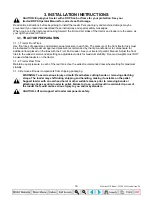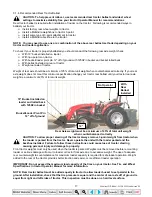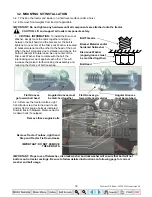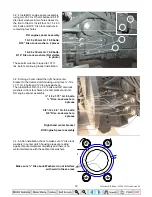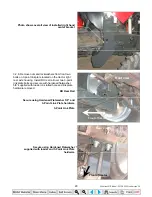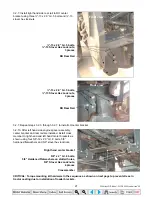
6
SAFETY PRECAUTIONS
50. If you must handle large heavy objects, protect yourself by using caution, moving slowly, and avoiding
bumps and rough ground.
51. If you must handle large heavy objects, protect yourself by never lifting load higher than necessary to
clear the ground.
52. If you must handle large heavy objects, protect yourself by adding rear ballast to the tractor to
compensate for weight of load.
53. If you must handle large heavy objects, protect yourself by never lifting large heavy objects that may roll
or fall on the operator.
54. Never lift any load from any point of the loader with a chain, rope, or cable unless loader is equipped with
a Factory approved attachment that was designed and built for this type of lifting. Always follow lifting
instructions included with these attachments.
55. Use only Factory bale probe or bale retaining devise handler attachment when handling round bales.
56. Do not handle large square bales without a retaining device handler attachment.
57. Do not use buckets, forks, or other attachments without bale retaining devices.
58. Do not use loader for handling large, heavy objects such as logs, tanks, etc.
SLOPES
59. Stay off of slopes too steep for safe operation.
60. Shift down before you start up or down a hill with a heavy load. Avoid "free wheeling."
61. Use extreme caution when operating on a slope.
62. Always operate up and down the slope, never across the slope.
ELECTRICAL
63. Avoid contact with overhead wires, power lines, and obstacles when loader bucket or attachment is
raised.
64. Electrocution from power lines can occur with or without contact.
65. Check for underground utilities before digging below grade level.
66. Contact with overhead power lines can cause severe electrical burns or death from electrocution. Make
sure there is enough clearance between raised equipment and overhead power lines.
HYDRAULIC
67. Do not tamper with the relief valve setting. This will void warranty and could cause damage to loader
and/or tractor.
68. Escaping hydraulic fluid under pressure can have sufficient force to penetrate the skin, causing serious
personal injury. Do not use HANDS to search for suspected leaks. If injured by escaping fluid, obtain
medical treatment immediately.
69. Visually check for hydraulic leaks and broken, missing, or malfunctioning parts. Never use your hand to
check for suspected leaks under pressure. Use a piece of cardboard or wood for this purpose. Escaping
hydraulic fluid or diesel fuel leaking under pressure can have sufficient force to penetrate the skin and
cause serious infection or other personal injury. If injured by leaking fluid, seek medical attention
immediately.
70. To prevent personal injury, relieve all pressure before disconnecting fluid lines.
71. Before applying hydraulic pressure, make sure all hydraulic connections are tight and components are in
good condition.
72. Be sure to purge all the air from the hydraulic system before attempting to raise or lower this machine.
73. When using remote hydraulic tractor valves on some tractors, the loader lift and dump cylinders will
continue moving unless the valve handle/handles are manually returned to neutral, or until relief pressure
is reached at the ends of piston strokes. Observe the bucket or attachment movement and maintain
control with valve handle/handles.
74. Raised loader or boom can fall due to hydraulic system failure.
75. To avoid serious injury or death: Block up or securely support loader and boom before working
underneath.
76. To avoid serious injury or death: Purge all air from hydraulic system before attempting to raise or lower
loader or boom.
77. To avoid serious injury or death: Stand clear if lowering or raising loader or boom.
78. Do not use hand or skin to check for hydraulic leaks. Use cardboard or wood. Wear eye protection.
35 Series 4WD, Model - 3535 & 4035 Loader June’08

















